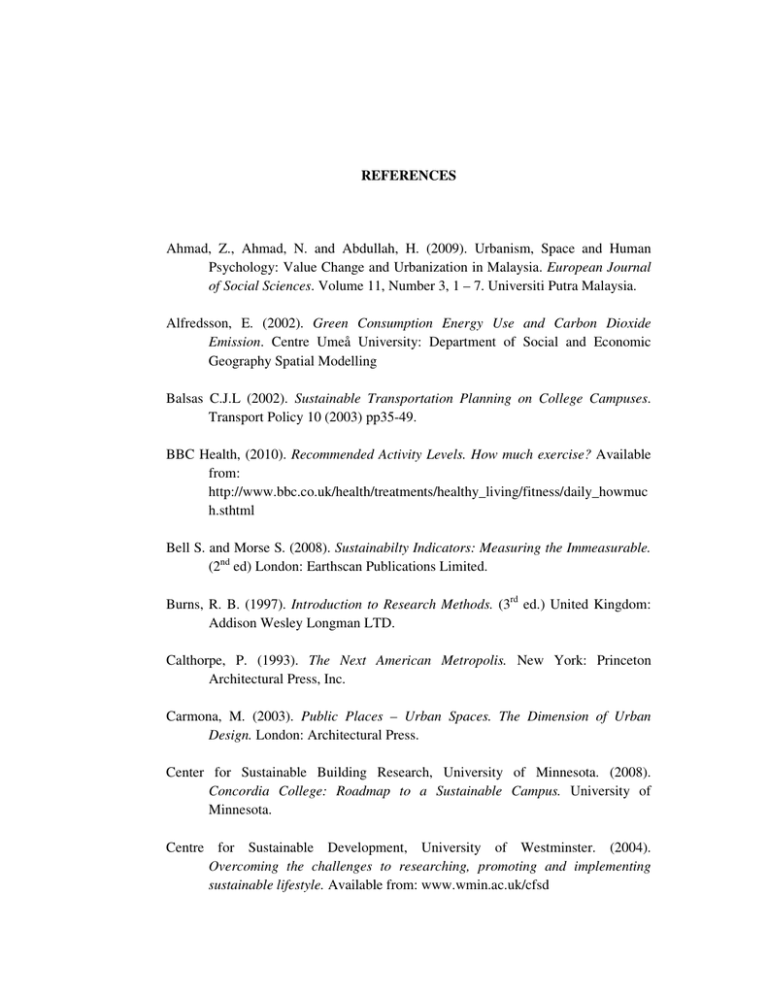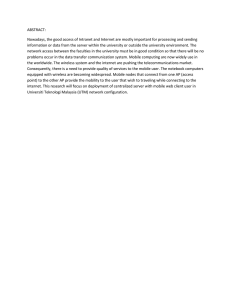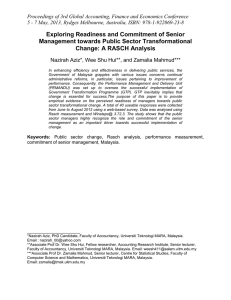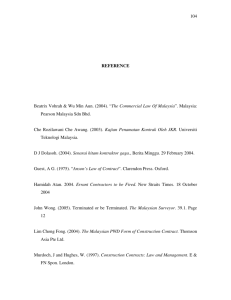Ahmad, Z., Ahmad, N. and ... European Journal
advertisement

REFERENCES Ahmad, Z., Ahmad, N. and Abdullah, H. (2009). Urbanism, Space and Human Psychology: Value Change and Urbanization in Malaysia. European Journal of Social Sciences. Volume 11, Number 3, 1 – 7. Universiti Putra Malaysia. Alfredsson, E. (2002). Green Consumption Energy Use and Carbon Dioxide Emission. Centre Umeå University: Department of Social and Economic Geography Spatial Modelling Balsas C.J.L (2002). Sustainable Transportation Planning on College Campuses. Transport Policy 10 (2003) pp35-49. BBC Health, (2010). Recommended Activity Levels. How much exercise? Available from: http://www.bbc.co.uk/health/treatments/healthy_living/fitness/daily_howmuc h.sthtml Bell S. and Morse S. (2008). Sustainabilty Indicators: Measuring the Immeasurable. (2nd ed) London: Earthscan Publications Limited. Burns, R. B. (1997). Introduction to Research Methods. (3rd ed.) United Kingdom: Addison Wesley Longman LTD. Calthorpe, P. (1993). The Next American Metropolis. New York: Princeton Architectural Press, Inc. Carmona, M. (2003). Public Places – Urban Spaces. The Dimension of Urban Design. London: Architectural Press. Center for Sustainable Building Research, University of Minnesota. (2008). Concordia College: Roadmap to a Sustainable Campus. University of Minnesota. Centre for Sustainable Development, University of Westminster. (2004). Overcoming the challenges to researching, promoting and implementing sustainable lifestyle. Available from: www.wmin.ac.uk/cfsd 91 Chin, Y. K. (2009). Estimation of Residential Carbon Dioxide Emission of Iskandar Malaysia by Using Energy Snapshot Tool. Bachelor Degree Project, Universiti Teknologi Malaysia, Skudai. Crowe T. D. (2000). Crime Prevention through Environmental Design: Application Architectural Design and Space Management Concepts. National Crime Prevention Institute. Amerika Syarikat. Creswell, J. W. (2003). Research Design: Qualitative, Quantitative and Mixed Method Approaches. (2nd ed) London: SAGE Publications. Department of Environment, IMPAK (2010). Malaysia’s Strategic Green Initiatives. (Issue 3, 2010). Ministry of Natural Resources and Environment. De Chiara, J., Panero, J. & Zelnik, M. (1995). Time Saver Standards for Housing and Residential Development. (2nd ed) Sinagpore: McGraw-Hill, Inc. Douglas, H. 2011. Definition of lifestyle. Available from: http://www.etymonline.com/ Duany, A. & Plater-Zyberk, E. (1944). The Neighborhood, the District and the Corridor. In Peter Katz. The New Urbanism: Toward an Architetcure of Community. United States of America: McGraw-Hill, Inc. Edwards B. (2005). Rough Guide to Sustainabilty. (2nd ed) London: RIBA Enterprise Ltd. Friedman, A. (2007). Sustainable Residential Development: Planning and Design for Green Neighborhoods. New York: McGraw-Hill. Gallion, A.B. & Eisner, S. (1963). The Urban Pattern: City Planning and Design. New York: Van Nostrand Reinhold Company. Greater London Council. Dept. of Architecture and Civic Design. An Introduction to Housing Layout. A GLC Study. (1980). London: The Architectural Press. Hall, K.B., Jr. and Porterfield, G.A. (2001). Community by Design, New Urbanism for Suburbans and Small Communities. New York: McGraw-Hill. Hester, R.T. (1975). Neighborhood Space. Penssylvania: Dowden, Hutchington & Ross Inc. 92 Ho, C.S. and Fong, W.K. (2007). Planning for Low Carbon Cities - The Case of Iskandar Development Region, Malaysia. Universiti Teknologi Malaysia, Skudai. Jabatan Perancangan Bandar dan Desa, JPBD. (2010). Draf Garis Panduan Perancangan Perumahan. Kuala Lumpur: Jabatan Perancangan Bandar dan Desa, Semenanjung Malaysia. Jan, G. (1996). Life between Buildings: Using Public Space. Denmark: Bianco Lunos Bogtrykkeri. Joshua, A. (2006). From Urban Sprawl to Compact City – An analysis of urban growth management in Auckland. Kee, C. L. L (2010). Sustainable Students’ Lifestyle in Achieving Sustainable Campus Concept. Master thesis, Universiti Teknologi Malaysia, Skudai. Keele University. (2008). http://www.keele.ac.uk/ Environment Policy. Available from: Moore, N. (2006). How to Do Research. A practical Guide to Designing and Managing Research Project. (3rd ed) London: Facet Publishing. Morgan, G. A. (2007). SPSS for Introducy Statistics: Use and Interpretation. (3rd ed) Mahwah, NJ: Lawrence Erlbaum. Newman, O. (1973). Defensible Space: Crime Prevention Through Urban Design in the Violent City. The Architectural Press Ltd: London, Great Britain. OECD. (1999). Towards more sustainable household consumption patterns: indicators to measure progress OECD. Ong, T. L. (2009). The Use of Principles of New Urbanism in Ang Mo Kio, Singapore. Bachelor Degree Project, Universiti Teknologi Malaysia, Skudai. Poyner B. and Webb B. (1991). Crime Free Housing. Oxford: Butterworth-Architect. Ranck, F. N. (1998). “Sidewalks and Paths” in Design and Safety of Pedestrian Facilities: A recommended Practice of the Institute of Transportation Engineers. Washington: Institute of Transportation Engineers. Rapoport A. (1997). Human Aspect of Urban Form towards a Man-Environment Approach to Urban Form and Design. England: Pergamon Press. 93 Rogers (2008). An introduction to Sustainable Development. Glen Educational Foundation Inc. Earthscan, UK. Ropke, I. (1999). The Dynamics of Willingness to Consume. Ecological Economics. 28: 399-420. Sapsford, R. (2007). Survey Research. (2nd ed.) London: SAGE Publications Ltd. Schmitt P. (1992). Sport for Sustainable Development. Olympic Movements’s Agenda 21. International Olympic Committee Sport and Environment Commision. Spaargaren, G., and VanVliet, B. (2000). Lifestyle, Consumption and the Environment: The Ecological Modernisation of Domestic Consumption. Environmental Politics. 9(1): 50-75. Tai, P. P. (2009). Application of Energy Snapshot Tool (ESS) in Reducing Carbon Dioxide Emissions of Freight Transportation (The Case of Iskandar Malaysia). Bachelor Degree Project, Universiti Teknologi Malaysia, Skudai. Taylor, N. (1998). Urban Planning Theory since 1945. London: SAGE Publications Ltd. University of Iowa (2010). Sustainability http://sustainability.uniowa.edu/ at Iowa. Available from: Untermann R. & Small R. (1977). Site Planning for Cluster Housing. United State of America: Van Nostrand Reinhold Company. Walliman, N. (2006). Social Research Methods. London: SAGE Publications. Western Australian Government (1997). Livable Neighborhoods: Community Design Code. Perth: Western Australian Planning Commision. Wheeler S.M. (2004). Planning for Sustainability: Creating Livable, Equitable and Ecological Communities. London: Routledge, Taylor & Francis Group. Walker, B. (1986). Public health responsibilities, roles, and realities. (1986). American Journal of Public Health. Washington. Xinxin, C. (2011). Redesign of a demolished neighborhood: Creating a healthy, safe and sociable Cabrini Green in Chicago. Master thesis, University of Illinois. 94 BIBLIOGRAPHY Abu, M. S. and Tasir, Z. (2001). Pengenalan Kepada Analisis Data Berkomputer: SPSS 10.0 for Windows. Kuala Lumpur: Venton Publishing. Agenda 21 (1992). United Nation Conference on Environment and Development. Rio de Janiero, Brazil. Bell D. and Hollows J. (2005). Ordinary Lifestyle: Popular Media, Consumption and Taste. United Kingdom: Open University Press. Brundtland Report (1987). World Commission on Environmental and Development (WCED). Comprehensive Development Plan for South Johor Economic Region 2006-2025. (2006). Kuala Lumpur: Khazanah Nasional. Glavic P. and Lukman R. (2007). Review of Sustainabilty Terms and Their Definitions. Journal of Cleaner Production. 15 (2007). Pp 1878-1855. Grant, Jill. (2006). Planning the Good Community: New Urbanism in Theory and Practice. New York: Routledge, Taylor & Francis Group. Green, S. B., Salkind, N. J. and Akey, T. M. (2000). Using SPSS for Windows: Analyzing and Understanding Data. (2nd ed.) Upper Sadle River, N. J.: Prentice Hall. Hall, Kenneth B. (2001). Community by Design: new Urbanism for Sururba and Small Communities. New York: McGraw-Hill. Jackson T. (2008). The Challenge of Sustainable Lifestyle in State of the World. Innovations for a Sustainable Economy. Jacobs, J. (1961). The Death and Life of Great American Cities. New York: Random House. 95 Katz P. (1994). The New Urbanism towards an Architectural of Community. McGraw-Hill, Inc. New York. Ariffin, H. (2011). Kertas Kerja 5. Perancangan Hijau dan Low Carbon Cities. 25th May 2011. Kuala Lumpur: Jabatan Perancangan Bandar dan Desa Semenanjung Malaysia. Lai, S.Y. (2006). Pencegahan Jenayah Melalui Reka Bentuk Susunatur Perumahan, Kajian Kes: Taman Ungku Tun Aminah dan Taman Mutiara Rini, Skudai. Bachelor Degree Project, Universiti Teknologi Malaysia, Skudai. Llweyn-Davis, Urban Design Compendium, English Partnerships & The Housing Corporation, London. Lynch, K. (1960). The Image of the City. Cambridge, MA: MIT Press. Moore, R.L. (1965). Physcological factors of importance in traffic engineering. In International Study Week in Traffic Engineering, 1-6 October, 1956, Stresa, Italy. London: World Touring and Automobile Organisation. Muhammad Zaly Shah (2003), Sampling Design. Quantitative Methods. Universiti Teknologi Malaysia, Skudai. Patspence (2010). What a “Sustainable Lifestyle” Really Means and How to Live One. Available from: http://www.brightbub.com/environment/greenliving/articles/77017.aspx Perry, C. A. The Neighborhood Unit. In Watson, D., Plattus, A., Shibley, R. (2003). Time-Saver Standard for Urban Design. New York: The McGraw-Hill Companies, Inc. Scott K. (2009). A Literature Review on Sustainable Lifestyle and Recomendation for Further Research. Stockholm Environment Institute, Project Report. Symposium on Low Carbon Asia Research Projects (4th -5th July 2011). Universiti Teknologi Malaysia. The New Urbanism: A better way to plan and build 21st Century Communities. New Urbanism News, Accessed on 10th November 2011. Available from: http://www.newurbannews.com/AboutNewUrbanism.html Zakaria, Z. and Md, H. (2001). Analisis Data Menggunakan SPSS Windows. Skudai: Universiti Teknologi Malaysia.




